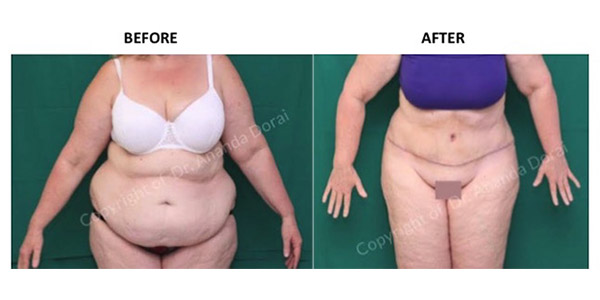INTRODUCTION
Abdominoplasty, commonly known as tummy tuck, is usually performed to remove excess fat and skin from the abdomen. The procedure also tightens the muscles of the to create the look of a flat and well-toned abdomen. Patients who asked for an abdominoplasty are usually those who have excess abdominal fat and skin either secondary to pregnancy and child bearing or after a period of weight loss.
The standard abdominoplasty covers the area between the pubic area and the navel. In the mini Abdominoplasty, a smaller incision is made but the surgical steps are otherwise similar with few technical differences.
During the initial consultation, patients will have the opportunity to discuss their goals and desirable results with the plastic surgeon. Every patient is different, therefore a specific treatment regimen is planned to suit an individual’s need.
PROCEDURE
The procedure is usually performed under general anaesthesia. The surgery takes about 3 to 4 hours. The approach to a full abdominoplasty often begins with skin incisions below the underwear line (from hip to hip above the pubic area). Another incision is made to release the belly button. The excess skin and fat tissues below the belly button are then excised. The upper abdominal skin is then pulled down like a window shade. The underlying weakened abdominal muscles are repaired. A new opening for the belly button is created. The upper abdominal wall is re-draped and positioned to the incisional wound made. The incisions are then closed with sutures.
Once the procedure is complete, temporary dressings or bandages will be applied to the incision site. Small tubes are temporarily placed under the skin to drain off excess blood or fluid that may be collected. When the tubes and dressings are removed, patients are advised to wear compression garment for 4-6 weeks to minimize the swelling and support the abdomen.The surgeon will advise you on how to take care of the wounds at home and you will be given a follow-up appointment.
RISKS
Although serious complications are uncommon, potential candidates should understand that every procedure comes with it a certain risk for possible complications and has a recovery period (down time). Stringent preoperative preparation and postoperative care can minimize their incidence.
The more common complications from abdominaplasty are:
- Bleeding (primary or secondary)
- Infection
- Poor wound healing
- Wound breakdown
- Scarring
- Skin discoloration
- Numbness
- Possibility of revision surgery
- Anaesthesia risks
- Asymmetry
POST-OPERATIVE EXPECTATIONS
After the surgery, there will be some swelling, bruising, discomfort and numbness for several days that can be controlled with oral medications, cold compression and ointments. The discomfort and bruising usually last between 2-3 weeks but in some patients, this can last longer. Patient are advise to rest for 1-2 weeks and can usually return to work after that.
Oral antibiotics and analgesics will be prescribed to reduce the risk of infection and postoperative pain respectively. Stitches will be removed about 2 weeks after the surgery. The final result of surgery will appear within several weeks, but it may take up to a year for the scar to fully mature.



